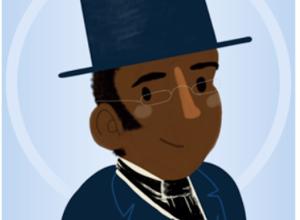Exhuming the Humument: The 5th Edition
Last week Tom Phillips celebrated his 75th birthday and the release of the 5th edition of The Humument: A Treated Victorian Novel, a watershed in the latter-day history of artists' books inspired by Surrealist methods in cutting, pasting, and heavy duty reassembly and collage. The work takes the text of A Human Document, by W. H. Mallock and effaces the pages in every which way: scraping, painting, pasting images, and obscuring huge swathes of text. As Phillips 'writes' on the title page: "I have to hide to reveal."
Unlike the Surrealists, and unlike anyone else working in 1966 when Phillips began the book, The Humument was not a one-off but something he wanted "to spend the rest of [his] life working on", "sometimes mining, sometimes undermining" and constantly remaking. So the work is not one story but many, with 80 new pages in and a few alterations of the original 367 treated pages, Phillips explained to a packed basement at the Review, an independent bookshop in Peckham, southeast London.
It was a fitting location, close to the spot where the great-grandaddy of DIY bookmaking, William Blake, hallucinated a tree full of angels, and more recently close to the (now-defunct) antique shop where Phillips first came across the book he would transform into The Humument. The shop was Austin's Furniture Repository, the price was a thruppence, another far cry from the present day, as Phillips pointed out that in 46 years using 15 copies of The Human Document in his art, Mallock's original has "seriously appreciated in value" to around £100-£200.
If the celebratory launch of the 5th edition was a chance for Phillips to reflect in good company about what has changed in his life since 1966 (for instance, The Humument's archive is now established at the Bodleian Library, Oxford), his selected readings from the new edition spoke to what has changed about life in general. For starters, the artist admitted that he has improved over time in cutting out words and sentences, shapes and shadows, from the book, a temperamental medium. The visual style has also evolved to include other interests on Phillip's part, for instance his extensive postcard collections. Among the additions to the story, Bill Toge, the "forced" protagonist of the novel, "condemned to appear, to be apart of the story whenever the word 'together' or 'altogether' occurs", experiences the horror of 9/11 ("nine eleven, the time singular, which broke down illusion") and the rise of social media. This is the first edition of the book where it is possible for a character to check her facebook profile on an app to find pictures of Bill Toge. And never merely a source for commentary, Phillips has already adapted the late 19th century work to the times in big way: as of 2010, it was translated into an app for iPad - with an added feature allowing readers to use the book as an oracle, combining bibliomancy with social networks (you can post your results on Facebook and Twitter).
As an oracle for the future of artists' books Phillip's Humument brings tidings from a world where digital apps complement rather than replace the works they represent, and where repetition is always an enriching experience ("your weaknesses become your strengths," Phillips noted when asked by a member of the audience why he was so repetitive). As Daniel Traister writes: "collage, a shaky assertion of stability, orders materials with no obvious or stable basis for their relationship into a framed composition". What was true for Dadaists and Surrealists, and each edition of The Humument, is now one way of thinking about the relationship between books and their digital counterparts: they are the new components of collage, of making meaning, and of creating stable links between otherwise unstable media.

















